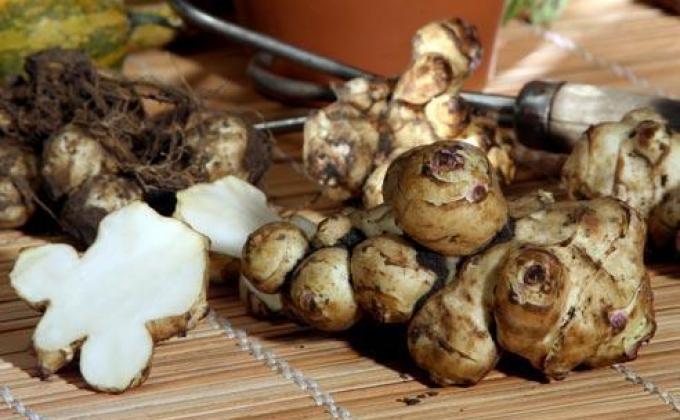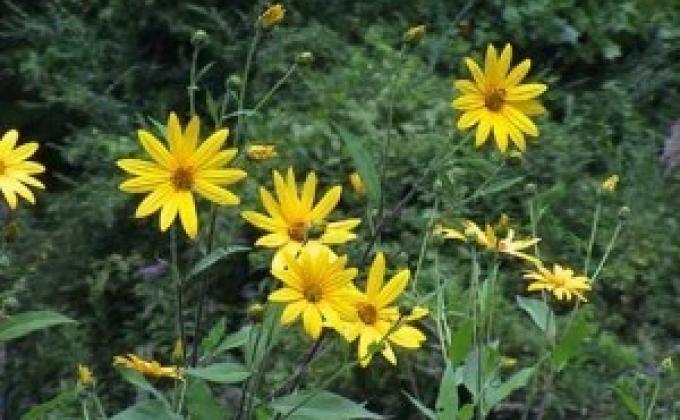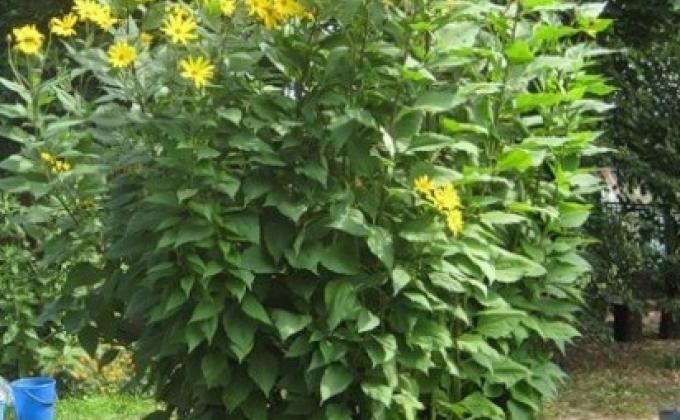
Knobby tubers of jerusalem artichoke, or ground pear, can be used instead of potatoes. This vegetable is suitable for those who want to lose weight, but not everyone will like it. To begin with, try planting one or two tubers. However, patients with diabetes do not have to choose much, so they can safely include Jerusalem artichoke in their diet. There is no starch in it, which is so dangerous for diabetics.
Jerusalem artichoke can be eaten raw in salads, and cooked in a variety of dishes.
The stems of the unpretentious and hardy Jerusalem artichoke grow up to 3 m in height, they form a good curtain from prying eyes or a screen to protect from the wind.
But it is not recommended to plant Jerusalem artichoke next to lower plants, otherwise they will be shaded.
Jerusalem artichoke inflorescences are similar to small sunflower inflorescences.
For planting, choose healthy tubers, by the way, even tubers cut into pieces if they are suitable for planting with an eye, Jerusalem artichoke bushes can grow perfectly from them.
A good time for planting is both autumn and early spring.
It may take 2-4 weeks from planting to the first shoots, the harvest of tubers from one plant is 1-2 kg, the time from planting to harvesting Jerusalem artichoke is 40-50 weeks. Jerusalem artichoke is an easy-to-cultivate plant, but its stems, swaying in the wind, may need support.
Jerusalem artichoke is undemanding to the soil, but it grows worse on acidified soils and in low-lying areas where water stagnates in spring. Jerusalem artichoke culture can be used to develop heavy soils. Before planting Jerusalem artichoke, the plot is shifted from autumn, compost is applied on poor soils.
Jerusalem artichoke tubers are planted in trenches. Then carefully fill the trench with earth and make a small ridge over the tubers with a rake. The planting depth of Jerusalem artichoke is 15 cm, the distance between tubers in a row is 45 cm, the distance between rows is 1 m. Jerusalem artichoke can be cleaned both in autumn and spring: in September - November or in April - May next year.
Jerusalem artichoke tubers
Caring for Jerusalem artichoke is not difficult. Watering is necessary in severe drought.
It is very convenient to plant Jerusalem artichoke along the fence.
In autumn, after the leaves wither, the stems of Jerusalem artichoke are cut at a height of 30 cm above the soil level. Jerusalem artichoke can be safely left to grow in one place for the winter, as it can withstand frosts up to -40.
In vegetable gardens, as a rule, unsorted jerusalem artichoke with white skin is grown. If you have the opportunity, purchase varietal planting material.
FUSEAU: This variety is worth growing. Tubers are white, elongated, with a more even surface than those of non-cultivar plants. The stems do not exceed 2 m in height.
DWARF SUN RAY: Tubers with a white skin that can not be removed. The variety is more cold-resistant than the previous one, but inferior to it in taste.
Problems of jerusalem artichoke cultivation
Jerusalem artichoke gets sick very rarely. But still there are possible diseases.
White rot or sclerotiniosis damages the bases of Jerusalem artichoke stems, as a result of which a white coating of mold forms on the stems. Black growths form inside the affected stems. Plants with such signs are immediately removed and burned.
In addition to the health benefits, Jerusalem artichoke will perfectly decorate your garden, because it blooms with beautiful yellow flowers.


